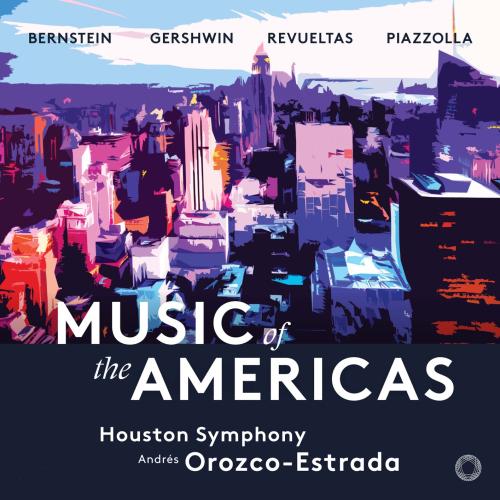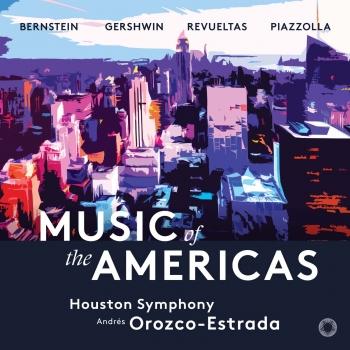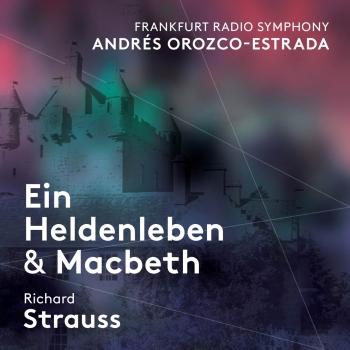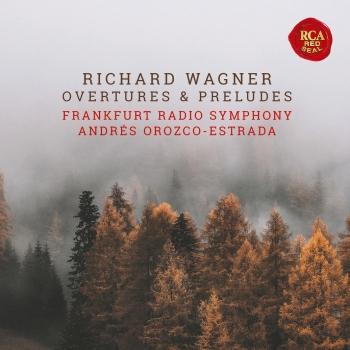
Music of the Americas Andrés Orozco-Estrada
Album info
Album-Release:
2018
HRA-Release:
16.02.2018
Label: PentaTone
Genre: Classical
Subgenre: Orchestral
Artist: Andrés Orozco-Estrada
Composer: Silvestre Revueltas (1899-1940), Leonard Bernstein (1918-1990), Ástor Piazzolla, George Gershwin (1989-1937)
Album including Album cover Booklet (PDF)
- Silvestre Revueltas (1899 - 1940): Sensemayá:
- 1 Sensemayá 06:27
- Leonard Bernstein (1918 - 1990): Symphonic Dances from West Side Story:
- 2 Symphonic Dances from West Side Story: I. Prologue 04:39
- 3 Symphonic Dances from West Side Story: II. Somewhere 04:17
- 4 Symphonic Dances from West Side Story: III. Scherzo 01:27
- 5 Symphonic Dances from West Side Story: IV. Mambo 02:28
- 6 Symphonic Dances from West Side Story: V. Cha-cha 00:58
- 7 Symphonic Dances from West Side Story: VI. Meeting Scene 00:50
- 8 Symphonic Dances from West Side Story: VII. Cool 00:41
- 9 Symphonic Dances from West Side Story: VIII. Fugue 03:01
- 10 Symphonic Dances from West Side Story: IX. Rumble 01:57
- 11 Symphonic Dances from West Side Story: X. Finale 03:20
- Ástor Piazzolla (1921 - 1992): Tangazo:
- 12 Tangazo: Variations on Buenos Aires 15:16
- George Gershwin (1898 - 1937): An American in Paris:
- 13 An American in Paris 19:58
Info for Music of the Americas
Having demonstrated their musical excellence with three well-received recordings on PENTATONE of orchestral works of Antonin Dvořák, Houston Symphony and Andrés Orozco-Estrada now present an album that comes closer to their cultural roots than ever before. Dance rhythms, jazzy harmonies, bright colours, city sounds; everything one associates with The Americas can be heard on this recording. With George Gershwin’s 1928 piece An American in Paris, Silvestre Revueltas’s Sensemayá (1938), Leonard Bernstein’s Symphonic Dances from West Side Story (1961) and Ástor Piazzolla’s Tangazo (1970), it brings together composers from across the twentieth century, all connected by their belonging to the Americas. Moreover, all of these composers reconfigured the barriers between classical and popular music, combining them to produce a sound that illustrates their home region. In choosing these particular works, Houston Symphony and Andrés Orozco-Estrada have aimed not to cover the entire continent but rather to provide ‘impressions’ of America and to ‘illuminate’ as many colours in the music as possible.
Sensemayá showcases the highly original combination of native elements from the pre-colonial indigenous past with avant-garde techniques that characterizes the music of Mexican composer Revueltas. Leonard Bernstein’s West Side Story, from which a suite of Symphonic Dances is featured on this album, belongs to the most popular and famous American music ever. Bernstein illuminates the story of two rival gangs in New York by juxtaposing a jazz-blues ‘American’ idiom with a more ‘Latin American’ Puerto Rican sound, in which the Cuban mambo and cha-cha, and the Mexican huapango are also integrated. Ástor Piazzolla’s Tangazo (grand tango) incorporates neo-classical elements such as a fugue into the national Argentinian dance music par excellence, realizing a reconciliation between native influences and trends in contemporary classical music. In Gershwin’s jazzy symphonic poem An American in Paris, city sounds temporarily give way to a sorrowful, homesickness blues, but the piece ends in regained excitement.
Houston Symphony Orchestra
Andres Orozco-Estrada, conductor
Andrés Orozco-Estrada
was born in Medellín (Colombia) and trained in Vienna. In September 2014, he took up the positions of Music Director of the Houston Symphony and Chief Conductor of the Frankfurt Radio Symphony Orchestra. From the 2015/16 season, he also became the Principal Guest Conductor of the London Philharmonic Orchestra. He previously served as Principal Conductor of the Tonkünstler Orchestra, with whom he developed a highly successful musical partnership from 2009 to 2015.
Andrés Orozco-Estrada conducts many leading orchestras worldwide, including the Vienna Philharmonic, the Santa Cecilia Orchestra in Rome, the Orchestre National de France, the Dresden Staatskapelle, the Leipzig Gewandhaus Orchestra, the Vienna Symphony and the Mahler Chamber Orchestra, as well as the orchestras of Philadelphia, Pittsburgh, Cleveland and Chicago. In the summer of 2014, he made his debut at Glyndebourne Festival Opera conducting Don Giovanni, for which he was immediately re-invited to conduct La Traviata in 2017. Following a thrilling début the previous year, summer 2016 marked his return to the Salzburg Festival with Nicolai's opera Il Templario and – in place of Nikolaus Harnoncourt – Beethoven's Ninth with the Concentus Musicus Wien.
His engagements for the 2016/17 season feature débuts with the San Francisco Symphony in April and the Berlin Philharmonic in May. Orozco-Estrada and the Frankfurt Radio Symphony will give a series of concerts as orchestra-in-residence in Vienna and Salzburg, in addition to undertaking tours to Budapest, Warsaw, Monte Carlo, the Dresden Music Festival and across Spain. He will also accompany Colombia's outstanding youth orchestra, the Filarmónica Joven de Colombia, on their first European tour, conducting eight concerts in Berlin and Stuttgart, at the Rheingau Music Festival, at the Mecklenburg-Vorpommern Festival and at the styriarte in Graz. Furthermore, he will embark on his first European tour with the Houston Symphony.
Current releases on Pentatone are generating a great deal of attention: his recent recordings of Stravinsky's Firebird and the Rite of Spring with the Frankfurt Radio Symphony have been praised as “musical storytelling of the highest calibre” (Kölner Stadtanzeiger) and “captivating recordings” (Gramophone). Following his most recent release, the first CD in his Richard Strauss cycle with the Frankfurt Radio Symphony (Ein Heldenleben and Macbeth), Gramophone labelled Orozco-Estrada “a fine Straussian”. He has also recorded the Dvořák symphonies 6, 7, 8 and 9 with the Houston Symphony, dubbed a “lively Dvořák with warm colours” by Pizzicato. Further recordings are in preparation. Complete symphonic recordings of Brahms and Mendelssohn are also available.
Andrés Orozco-Estrada began his musical studies on the violin before receiving his first conducting lessons at the age of 15. In 1997, he moved to Vienna where he joined the conducting class of Uroš Lajovic, pupil of the legendary Hans Swarowsky, at the renowned Vienna Music Academy. Orozco-Estrada currently lives in Vienna.
Booklet for Music of the Americas














